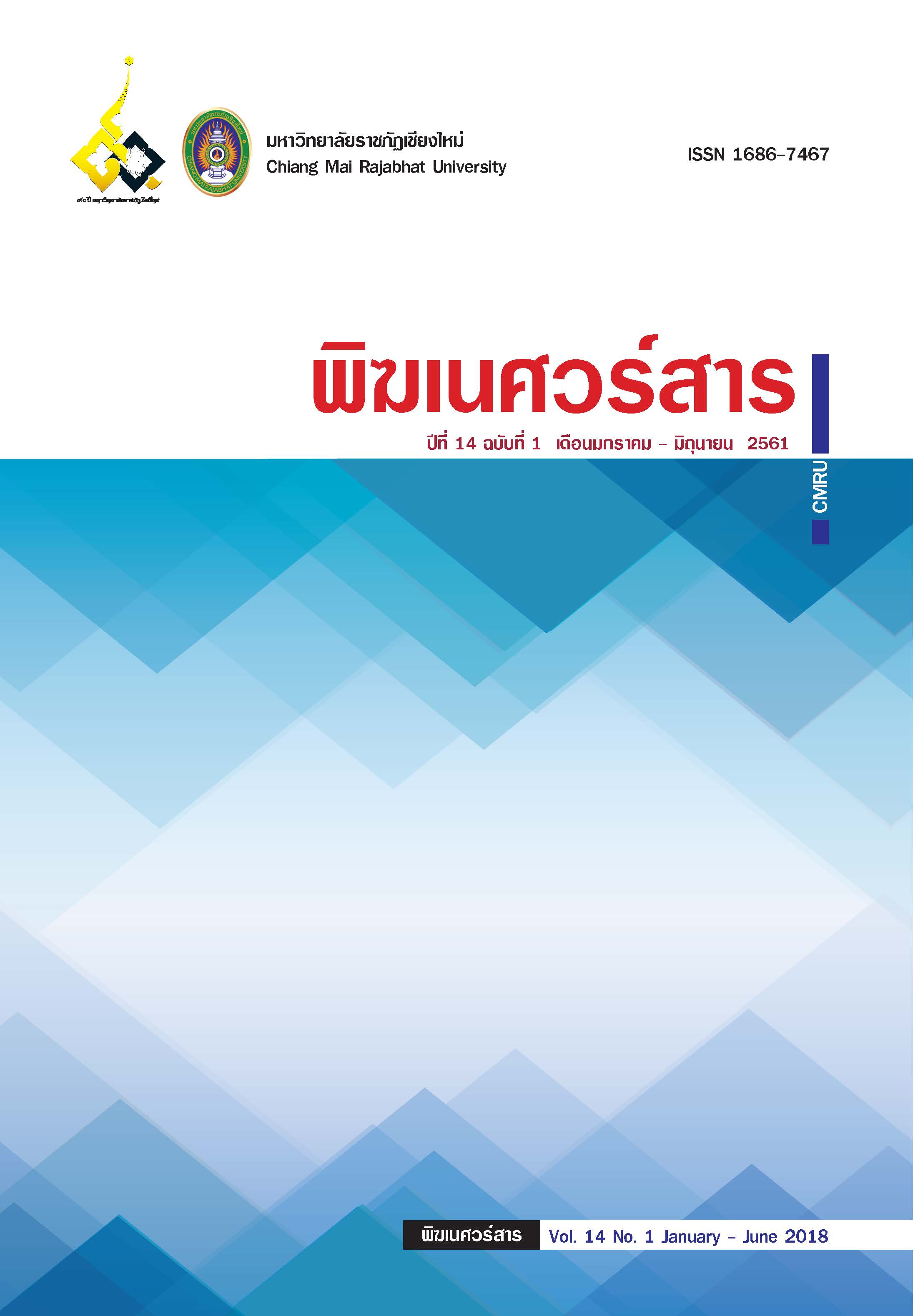พฤติกรรมการแสวงหาและ การเข้าถึงการบริการด้านสุขภาพของแรงงานไทยใหญ่ ในตำบลสันผักหวาน อำเภอหางดง จังหวัดเชียงใหม่
Main Article Content
บทคัดย่อ
การศึกษาพฤติกรรมการแสวงหาและการเข้าถึงการบริการด้านสุขภาพของแรงงานไทยใหญ่ในตำบลสันผักหวาน อำเภอหางดง จังหวัดเชียงใหม่เป็นการศึกษาเชิงพรรณนา มีวัตถุประสงค์เพื่อศึกษาพฤติกรรมการแสวงหาและการเข้าถึงบริการด้านสุขภาพของแรงงานไทใหญ่ ในตำบลสันผักหวาน อำเภอหางดง จังหวัดเชียงใหม่ เก็บข้อมูลจากกลุ่มตัวอย่าง จำนวน 181 คน ระหว่างเดือนมีนาคม พ.ศ. 2560 โดยใช้แบบสอบถาม วิเคราะห์ข้อมูลโดยใช้ค่าร้อยละ ค่าเฉลี่ย และทดสอบความสัมพันธ์ระหว่างปัจจัยส่วนบุคคลกับอุปสรรคในการแสวงหาและการเข้าถึงการบริการด้านสุขภาพโดยใช้การทดสอบไคสแควร์
ผลการวิจัยพบว่า กลุ่มตัวอย่างส่วนใหญ่เป็นเพศชาย ร้อยละ 61.9 มีอายุระหว่าง 30-39 ปี ร้อยละ 38.1 ส่วนใหญ่มาจากเมืองต่าง ๆ ของรัฐฉาน แต่ไม่ได้ระบุภูมิลำเนาเดิม ร้อยละ 44.8 นับถือศาสนาพุทธ ร้อยละ 89.5 ไม่ได้เรียนหนังสือ ร้อยละ 42.0 กลุ่มตัวอย่างส่วนใหญ่แต่งงานแล้ว ร้อยละ 65.7 จำนวนสมาชิกในครอบครัว 3-4 คน ร้อยละ 43.1 กลุ่มตัวอย่างเข้ามาทำงานในประเทศไทย 3-4 ปี ร้อยละ 43.1 โดยมีหนังสือเดินทางข้ามประเทศ ร้อยละ 49.7 และจดทะเบียนแรงงานอย่างถูกต้องตามกฎหมาย ร้อยละ 84.4 ส่วนใหญ่ทำอาชีพก่อสร้าง ร้อยละ 60.8 กลุ่มตัวอย่างเลือกใช้บริการร้านขายยาในพื้นที่เป็นประจำ ส่วนใหญ่อุปสรรคของการเข้าถึงบริการด้านสุขภาพ คือ ระยะเวลาของการรอที่ยาวนาน ขณะที่ปัจจัยส่วนบุคคลไม่มีความสัมพันธ์กับการเข้าถึงบริการด้านสุขภาพ
Article Details
บทความที่ได้รับการตีพิมพ์เป็นลิขสิทธิ์ของบัณฑิตวิทยาลัย มหาวิทยาลัยราชภัฎเชียงใหม่
ข้อความที่ปรากฏในบทความแต่ละเรื่องในวารสารวิชาการเล่มนี้เป็นความคิดเห็นส่วนตัวของผู้เขียนแต่ละท่านไม่เกี่ยวข้องกับมหาวิทยาลัยราชภัฎเชียงใหม่ และคณาจารย์ท่านอื่นๆ ในมหาวิทยาลัยฯ แต่อย่างใด ความรับผิดชอบองค์ประกอบทั้งหมดของบทความแต่ละเรื่องเป็นของผู้เขียนแต่ละท่าน หากมีความผิดพลาดใด ๆ ผู้เขียนแต่ละท่านจะรับผิดชอบบทความของตนเองแต่ผู้เดียว
References
Archavanitkul, K. (2007). The Thai State and Changes in AIDS and Reproductive Health Policies for Undocumented Migrants. NakhonPathom, Thailand: Institute for Population and Social Research, Mahidol University.
Aung, T., Pongpanich, S., and Robson, M. G. (2009) Health seeking behaviors among Myanmar migrant workers in Ranong Province, Thailand. J Health Res 23 Suppl, 5–9.
Choy et al. (2011). Reporting of Occupational Diseases in Singapore. The Singapore Family Physician, 37(2).
Del Amo, J., Likatavičius, G., Pérez-Cachafeiro, S., Hernando, V., González, C., Jarrín, I. … Bolúmar, F. (2011). The epidemiology of HIV and AIDS reports in migrants in the 27 European Union countries, Norway and Iceland: 1999-2006. Eur J Public Health, 21(5), 620-6. doi: 10.1093/eurpub/ckq150. Epub 2010 Nov 4.
Hu, X., Cook, S. and Salazar, M. A. (2008). Internal migration and health in China. The Lancet, 372(9651), 1717–1719.
International Labour Organization. (2015). New ILO figures show 150 million migrants in the global workforce. Retrived from http://www.ilo.org/global/topics/labour-migration/newstatements/WCMS_436140/lang--en/index.html
Isarabhakdi, P. (2004). Meeting at the Crossroads: Myanmar Migrants and Their Use of Thai Health Care Services. Asia Pac Migr J, 13(1), 107-126.
Kanchanajittra, C., Podhisita, C., Archavanitkul, K., Pattaravanich, U., Siriratmongkon, K., and Seangdung, H. (2007). Thai health 2007. NakornPathom: Institute of Population and
Social Research, Mahidol University.
Krejcie, R. V. and Morgan, D. W. (1970). Determining Sample Size for Research Activities. Educational and Psychological Measurement, 30(3), 607-610.
Lee, W., Neo, A., Tan, S., Cook, A. R., Wong, M. L., Tan, J., ... and Mark, I. (2014). Health-seeking behaviour of male foreign migrant workers living in a dormitory in Singapore. BMC health services research, 14(1), 300.
Li, X., Stanton, B., Fang, X., Xiong, Q., Yu, S., Lin, D., and Wang, B. (2009). Mental health symptoms among rural-to-urban migrants in China: A comparison with their urban and rural counterparts. World Health and Population, 11(1), 24–38.
Pearson, E., Punpuing, S., Jampaklay, A., Kittisuksathit, S., and Prohmmo, A. (2006). The Mekong challenge: Underpaid, overworked and overlooked: The realities of young migrant workers in Thailand. International Programme on the Elimination of Child Labor, International Labor Organization.
Peng, Y., Chang, W., Zhou, H., Hu, H., & Liang, W. (2010). Factors associated with health-seeking behavior among migrant workers in Beijing, China. BMC health services research, 10(1), 69.
Price, N. (2001). The performance of social marketing in reaching the poor and vulnerable in AIDS control programs. Health Policy and Planning, 16(3), 231-239.
Runganga, A., Sundby, J. and Aggleton P. (2001) Culture, Identity and Reproductive Failure in Zimbabwe. Sexualities, 4(3), 294-315.
Srithamrongsawat, S., Wisessang, R., and Ratjaroenkhajorn, S. (2009). Financing healthcare for migrants: a case study from Thailand. International Organization for Migration.
Steen, T. and Mazonde, G. (1999). Ngaka ya setswana, Health seeking behaviour in Batswana with pulmonary tuberculosis. Social Science & Medicine, 48(2), pp.163-172.
Suwanvanichkij, V. (2008). Displacement and disease: The Shan exodus and infectious disease implications for Thailand. Conflict and Health, 2(1), 4.
Song, W.Y. (2006). Research on Health Status of Female Migrant Workers and Relevant Factors. (Master’s Thesis, Suzhou U)
Li, S., Huang, H., Cai, Y., Xu, G., Huang, F., and Shen, X. (2009) Characteristics and determinants of sexual behavior among adolescents of migrant workers in Shanghai (China). BMC Public Health, 9, 194-204
Thomas, J. J. and Borrayo, E. A. (2014). The combined influence of psychosocial factors on illness behavior among women. Women Health, 54(6), 530-51. doi:10.1080/03630242.2014.903886.
United Nations, Department of Economic and Social Affairs, Population Division (2016). International Migration Report 2015 (ST/ESA/SER.A/384). United Nations.
WHO Thailand and Department of Disease Control. (2005). Ministry of Public Health: Overview of Thai-Myanmar Border Health Situation. Retrieved from http://w3.whothai.org/EN/Section3/Section39.html
World Health Organization. (2001). A human rights approach to tuberculosis. Geneva, Switzerland: World Health organization, 12-13.

